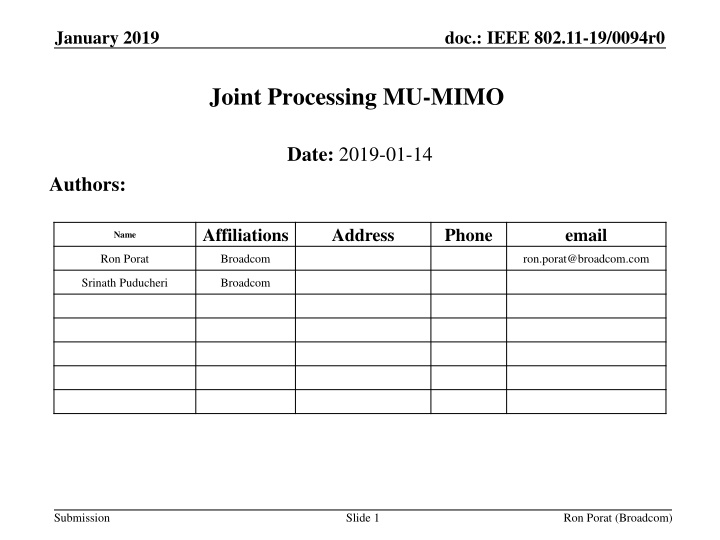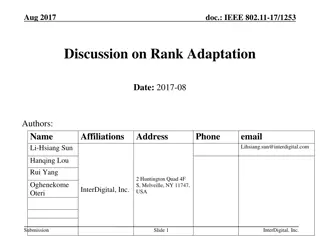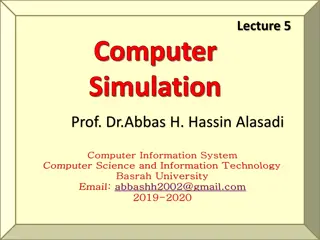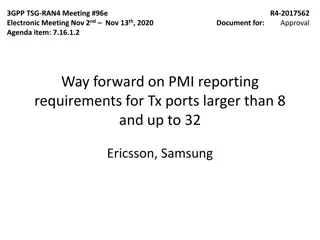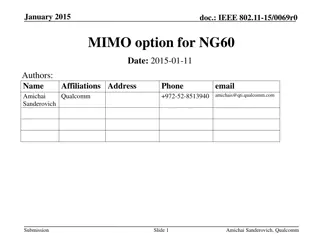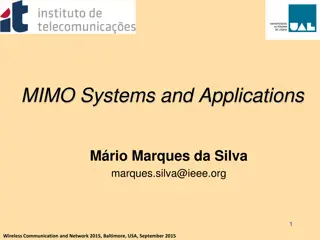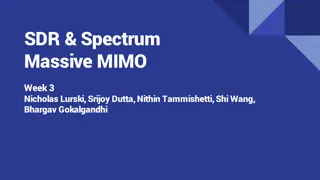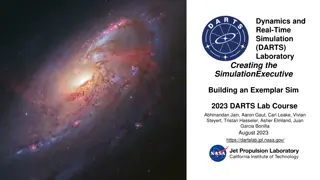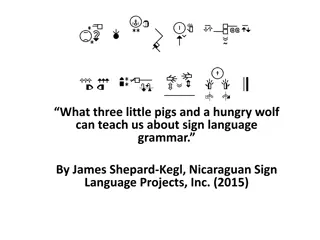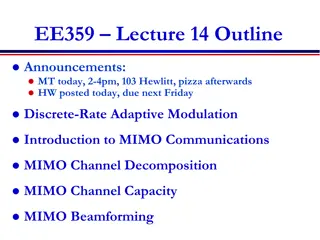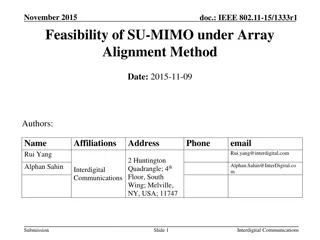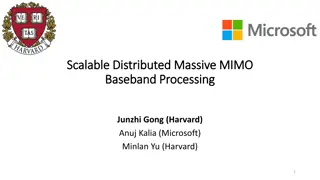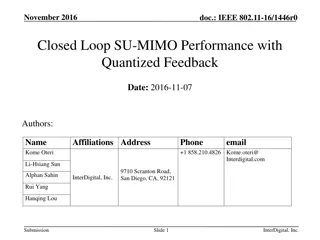Joint Processing MU-MIMO Framework Simulation Results and Solutions
Introduction of a framework for joint processing MU-MIMO operation utilizing wireless synchronization techniques, addressing clock drift issues and proposing solutions for accurate CFO estimation. Simulation results are provided to validate the proposed framework.
Uploaded on Mar 19, 2025 | 3 Views
Download Presentation

Please find below an Image/Link to download the presentation.
The content on the website is provided AS IS for your information and personal use only. It may not be sold, licensed, or shared on other websites without obtaining consent from the author.If you encounter any issues during the download, it is possible that the publisher has removed the file from their server.
You are allowed to download the files provided on this website for personal or commercial use, subject to the condition that they are used lawfully. All files are the property of their respective owners.
The content on the website is provided AS IS for your information and personal use only. It may not be sold, licensed, or shared on other websites without obtaining consent from the author.
E N D
Presentation Transcript
January 2019 doc.: IEEE 802.11-19/0094r0 Joint Processing MU-MIMO Date: 2019-01-14 Authors: Affiliations Address Phone email Name Ron Porat Broadcom ron.porat@broadcom.com Srinath Puducheri Broadcom Submission Slide 1 Ron Porat (Broadcom)
January 2019 doc.: IEEE 802.11-19/0094r0 Abstract In the September meeting contribution number 1439 we introduced a framework for joint processing (previously called distributed) MU-MIMO operation using wireless synchronization techniques, building on mechanisms that exist in 11ax. In this contribution we provide simulation results for the proposed framework Problems reminder Problem A - from the time of NDP (when channel feedback is collected) to the time of joint data transmission, each AP drifts based on its own (e.g. 20ppm) clock. In addition, AP acquisition timings vary each packet. Problem B during joint data transmission, APs start drifting again due to residual CFO error Proposed solutions reminder Problem A - slave triggers are sent before the NDP and before joint data transmissions to enable drift estimation. The slave trigger enables capturing the exact phase drift which will include the impact of CFO and phase noise. Problem B we propose accurate CFO estimation Submission Slide 2 Ron Porat (Broadcom)
January 2019 doc.: IEEE 802.11-19/0094r0 Problem A - Phase alignment before the joint data transmission Submission Slide 3 Ron Porat (Broadcom)
January 2019 doc.: IEEE 802.11-19/0094r0 Estimation Each slave AP uses the channel estimates from the slave triggers, denoted here by the vectors h_ndp (from the trigger before the NDP) and h_data (from the trigger before the joint data transmission) to calculate two parameters related to the phase drift: Timing errors (acquisition error) these are manifested as a linear phase drift across frequency. Common phase drift due to different RF clocks and phase noise between the Master and each slave AP We assume here for tone i where all other impairments are lumped into the noise component (incl. channel aging) And then form, as an example, the following metric: = j i + + _ ( ) _ ( )exp( ( )) h data i h ndp i N i = = j i + + _ ( ) _ * ( _ )/ _ _ ( ) exp( ( )) h diff i h data conj h ndp h ndp h ndp i N i With MIMO configuration, this metric is summed up across the receive antennas It is straightforward to form metrics to estimate theta and phi from h_diff. Submission Slide 4 Ron Porat (Broadcom)
January 2019 doc.: IEEE 802.11-19/0094r0 Simulation Methodology We employ two sets of simulations the first simulation is used to estimate phase and timing error. The second simulation performs joint MU-MIMO transmission whereby each slave AP has an offset in the amount of the residual estimation error relative to the master AP. Both sets of simulations use the 11nD channel model with -30dBc aging and BW=80MHz. Residual common and linear phase errors are simulated across 1000 channel realizations using one beamformed 4x LTF In the joint MU-MIMO simulation each slave AP is assumed to have as input the same 10% worst residual phase error for all channel instantiations. We calculate average MU SINR per STA per spatial stream with and without impairments and plot them. Submission Slide 5 Ron Porat (Broadcom)
January 2019 doc.: IEEE 802.11-19/0094r0 Simulation Configurations We believe the vast majority of cases for mesh deployments will involve 4-antenna AP. Hence we focus on two configurations: Two 4-antenna AP (one master one slave) Four 4-antenna AP (one master three slaves) Each configuration is 75% loaded - 2 streams to three or six 2-antenna STA for a total of 6 or 12 streams In terms of SNR we have a 2D problem AP-AP SNR and STA-AP SNR. For simplicity we ran simulations assuming 2 fixed AP-AP SNR values 10 and 20 dB and varied the STA-AP SNR. We assume all STA have the same SNR to all AP. Submission Slide 6 Ron Porat (Broadcom)
January 2019 doc.: IEEE 802.11-19/0094r0 Results Two AP Four AP No significant impact on the average per-STA MU-SINR is seen as the residual timing/phase estimation error are small Submission Slide 7 Ron Porat (Broadcom)
January 2019 doc.: IEEE 802.11-19/0094r0 Problem B - Controlling the drift during joint data transmission Submission Slide 8 Ron Porat (Broadcom)
January 2019 doc.: IEEE 802.11-19/0094r0 High Level Description At the beginning of the joint data transmission, all the APs are phase/time-synchronized with very small residual error based on the description of problem A. However, during the joint transmission the APs will start drifting again which will cause the phase offset between them to increase with time. In the following slides we estimate the performance degradation with various fixed phase offsets between the APs and provide a result for CFO estimation. Simulation scenarios same configuration as problem A. Simulation methodology - we compare the joint processing MU-MIMO performance of multiple APs relative to a baseline comprising of TDMA between single APs: The baseline also assumes 75% loading MU-MIMO We assume equal sum power for joint processing as for the baseline single AP (in the following slide the X-axis means total power across all AP) This is similar to assumptions made for MU-MIMO but in this case alternatively per-AP fixed power can be assumed, yielding higher gains. Submission Slide 9 Ron Porat (Broadcom)
January 2019 doc.: IEEE 802.11-19/0094r0 Results Two AP Four AP 8 degrees of phase offset still provide substantial gains Submission Slide 10 Ron Porat (Broadcom)
January 2019 doc.: IEEE 802.11-19/0094r0 CFO Estimation Accurate CFO estimation at the slave AP is important to minimizing the phase drift between slave and master AP during the joint data transmission. For an example here, we have leveraged the 4x LTF in 11ax to improve CFO estimation beyond the performance available from the L-LTF by assuming in exactly the same manner that we have two identical and adjacent 4x LTF (in the HE-LTF part) and estimated the phase drift between them. For the AP configuration assumed throughout (4-ant AP for master and slave) we got 30Hz residual CFO error in moderate SNR Submission Slide 11 Ron Porat (Broadcom)
January 2019 doc.: IEEE 802.11-19/0094r0 Summary Our investigation demonstrates the feasibility of this scheme by proving that estimation techniques can compensate for the drift between slave and master APs. This is achieved using the following two components: First, estimating and compensating the total phase drift between the NDP and the joint data transmission Second, estimating CFO accurately to minimize phase drift during the joint data transmission Submission Slide 12 Ron Porat (Broadcom)
